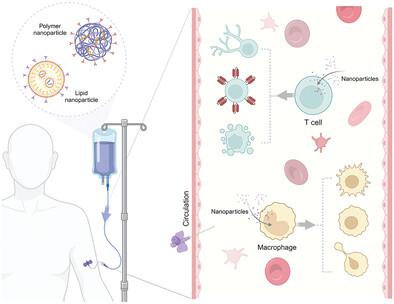当前位置:
X-MOL 学术
›
Adv. Mater.
›
论文详情
Our official English website, www.x-mol.net, welcomes your
feedback! (Note: you will need to create a separate account there.)
In Situ Reprogramming of Immune Cells Using Synthetic Nanomaterials
Advanced Materials ( IF 27.4 ) Pub Date : 2024-01-17 , DOI: 10.1002/adma.202310168 Shihong Nie 1 , Yuyang Qin 1, 2 , Liyuan Ou 2 , Xiaoyuan Chen 3, 4, 5 , Ling Li 2
Advanced Materials ( IF 27.4 ) Pub Date : 2024-01-17 , DOI: 10.1002/adma.202310168 Shihong Nie 1 , Yuyang Qin 1, 2 , Liyuan Ou 2 , Xiaoyuan Chen 3, 4, 5 , Ling Li 2
Affiliation

|
In the past decade, adoptive cell therapy with chimeric antigen receptor-T (CAR-T) cells has revolutionized cancer treatment. However, the complexity and high costs involved in manufacturing current adoptive cell therapy greatly inhibit its widespread availability and access. To address this, in situ cell therapy, which directly reprograms immune cells inside the body, has recently been developed as a promising alternative. Here, an overview of the recent progress in the development of synthetic nanomaterials is provided to deliver plasmid DNA or mRNA for in situ reprogramming of T cells and macrophages, focusing especially on in situ CAR therapies. Also, the main challenges for in situ immune cell reprogramming are discussed and some approaches to overcome these barriers to fulfill the clinical applications are proposed.
中文翻译:

使用合成纳米材料对免疫细胞进行原位重编程
在过去的十年中,嵌合抗原受体 T (CAR-T) 细胞的过继细胞疗法彻底改变了癌症治疗。然而,当前过继细胞疗法的制造过程复杂且成本高昂,极大地限制了其广泛的可用性和获取。为了解决这个问题,原位细胞疗法最近被开发为一种有前途的替代方案,它可以直接重新编程体内的免疫细胞。本文概述了合成纳米材料开发的最新进展,以传递质粒 DNA 或 mRNA 以对 T 细胞和巨噬细胞进行原位重编程,特别关注原位 CAR 疗法。此外,还讨论了原位免疫细胞重编程的主要挑战,并提出了一些克服这些障碍以实现临床应用的方法。
更新日期:2024-01-17
中文翻译:

使用合成纳米材料对免疫细胞进行原位重编程
在过去的十年中,嵌合抗原受体 T (CAR-T) 细胞的过继细胞疗法彻底改变了癌症治疗。然而,当前过继细胞疗法的制造过程复杂且成本高昂,极大地限制了其广泛的可用性和获取。为了解决这个问题,原位细胞疗法最近被开发为一种有前途的替代方案,它可以直接重新编程体内的免疫细胞。本文概述了合成纳米材料开发的最新进展,以传递质粒 DNA 或 mRNA 以对 T 细胞和巨噬细胞进行原位重编程,特别关注原位 CAR 疗法。此外,还讨论了原位免疫细胞重编程的主要挑战,并提出了一些克服这些障碍以实现临床应用的方法。















































 京公网安备 11010802027423号
京公网安备 11010802027423号